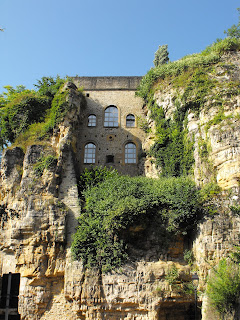On Saturday the 10th we took a slightly less than 1 hour train ride to Clervaux in the north of Luxembourg
An additional “treat” awaited us: the "best" Gregorian chants east of the Rhine by Benedictine monks at the Abbey de St. Maurice. We began walking up the road, for the Abbey stood prominently above the town and the Chateau on a not-quite-mountain but certainly more-than-hill. The heat wave from the United States
And yet the path was not entirely punishing or austere, for along it I found the remains of a garden life: horseradish and currant bushes, foxglove, heather, and Scotch brooms, not to mention the ubiquitous woodland (mostly Ostrich) ferns. Who knew penance could be so gratifying?
 Thus if I could append a subtitle to the subtitle, it would be “whimsy.” Luxembourgian gardens are to my untrained eye an exercise of whimsy, which may be defined in two senses. First, as intimated by the photographs in my previous entry (but which the severely sleep-deprived mind could not articulate), Luxembourgian gardens may be formal (perhaps the ordering dictate of diminutive plots of land in a diminutive country), but this formality is punctuated or assuaged or mitigated by a distinct playfulness: whimsical accoutrements (certainly not of the pink flamingo or garden gnome sort), shapes of boxwood hedges, Grecian blue wading pools, and color.
Thus if I could append a subtitle to the subtitle, it would be “whimsy.” Luxembourgian gardens are to my untrained eye an exercise of whimsy, which may be defined in two senses. First, as intimated by the photographs in my previous entry (but which the severely sleep-deprived mind could not articulate), Luxembourgian gardens may be formal (perhaps the ordering dictate of diminutive plots of land in a diminutive country), but this formality is punctuated or assuaged or mitigated by a distinct playfulness: whimsical accoutrements (certainly not of the pink flamingo or garden gnome sort), shapes of boxwood hedges, Grecian blue wading pools, and color. And Luxembourgian gardens are whimsical in yet another sense: one finds plants in the most unexpected of places, remains of a day long past. I sighted rose bushes on the 2nd level of a 15th century guard tower, now a lone sentinel, its walls having collapsed around it long ago, and poppies at its base; heather and Scotch broom, foxgloves and currant bushes in the middle of the woods on a path to the Benedictine monastery.
Luxembourg lacks the grand, pretentious boulevards of many a European city, though it surely is spectacular in its diminutiveness, and that, I think, owes to the spirit of the people: playful, casual, and every bit as prone to celebrating the remains of many a previous day just as much as they look forward to a profitable and gleaming future—but always constrained by a formality within which you can be as whimsical as you like.




No comments:
Post a Comment